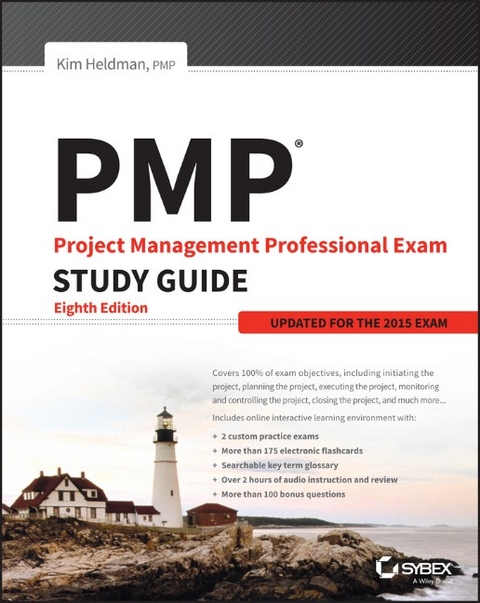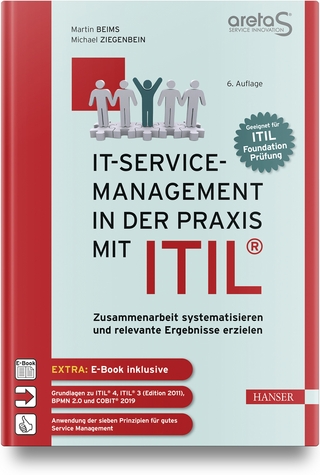
PMP: Project Management Professional Exam Study Guide
John Wiley & Sons Inc (Verlag)
978-1-119-17967-2 (ISBN)
- Titel ist leider vergriffen;
keine Neuauflage - Artikel merken
PMP® Study Guide, 8th Edition is a complete resource for PMP® exam preparation, featuring full coverage of
all exam objectives, hands–on practice, and plenty of interactive tools. Fully updated to reflect the Project Management Institute′s latest changes to the exam, this new edition includes the revised best practices in alignment with PMBOK® 5th edition. You′ll find detailed discussion on a wide range of project management topics, concepts, and key terms, alongside frequent opportunities to gain hands–on practice using these skills in typical workplace scenarios. Each chapter includes comprehensive review questions to help you gauge your understanding, and you also gain access to the Sybex interactive online learning environment that features electronic flash cards, chapter tests, practice exams, and more.
The IT marketplace demands certified project management professionals, and the PMP® certification was created specifically to address that demand. Now considered the premier project management credential, the PMP requires candidates to undergo a grueling four–hour exam. This book gives you everything you need to improve your skills and take the exam with confidence.
Get hands–on practice in real–world scenarios
Relate each objective to your current project
Test your understanding with practice tests and more
The PMP® Study Guide is your ultimate preparation resource for passing the PMP®.
(PMI, PMBOK, CAPM, PMP, and Project Management Professional are registered marks of the Project Management Institute, Inc.)
Kim Heldman, PMP, is the Chief Information Officer for the Regional Transportation District in Denver, Colorado. She has over 25 years of experience in project management and more than 18 years of experience in senior management positions. Kim is the author of several books on project management, including Project Management JumpStart, 3rd Edition, and the seven previous editions of the bestselling PMP Project Management Professional Study Guide. You can visit Kim′s website at www.kimheldman.com.
Introduction xxi
Assessment Test xxxii
Chapter 1 What Is a Project? 1
Is It a Project? 2
Projects vs. Operations 3
Stakeholders 5
Project Characteristics 7
What Is Project Management? 7
Programs 8
Portfolios 9
Project Management Offices 10
Skills Every Good Project Manager Needs 12
Communication Skills 13
Organizational and Planning Skills 13
Conflict Management Skills 14
Negotiation and Influencing Skills 14
Leadership Skills 15
Team ]Building and Motivating Skills 15
Role of a Project Manager 16
Understanding Organizational Structures 16
Functional Organizations 17
Projectized Organizations 20
Matrix Organizations 22
Project ]Based Organizations 26
Understanding Project Life Cycles and Project Management Processes 26
Project Phases and Project Life Cycles 26
Project Management Process Groups 29
Understanding How This Applies to Your Next Project 36
Summary 36
Exam Essentials 37
Review Questions 39
Chapter 2 Creating the Project Charter 45
Exploring the Project Management Knowledge Areas 47
Project Integration Management 49
Project Scope Management 50
Project Time Management 51
Project Cost Management 51
Project Quality Management 52
Project Human Resource Management 53
Project Communications Management 54
Project Risk Management 55
Project Procurement Management 55
Project Stakeholder Management 56
Understanding How Projects Come About 56
Needs and Demands 57
Feasibility Studies 59
Performing Project Selection and Assessment 60
Using Project Selection Methods 62
Applying Project Selection Methods 68
Kicking Off the Project Charter 70
Project Statement of Work 70
Business Case 71
Agreements 72
Enterprise Environmental Factors 72
Organizational Process Assets 73
Tools and Techniques 75
Formalizing and Publishing the Project Charter 75
Pulling the Project Charter Together 76
Key Stakeholders 76
Project Charter Sign ]Off 79
Identifying Stakeholders 79
Identify Stakeholders Inputs 79
Stakeholder Analysis 80
Stakeholder Register and Strategy 83
Introducing the Kitchen Heaven Project Case Study 83
Understanding How This Applies to Your Next Project 87
Summary 88
Exam Essentials 89
Review Questions 91
Chapter 3 Developing the Project Scope Statement 97
Developing the Project Management Plan 99
Developing Inputs 100
Documenting the Project Management Plan 102
Plan Scope Management 104
Understanding the Plan Scope Management Inputs 105
Using Plan Scope Management Tools and Techniques 106
Documenting the Scope Management Plan 107
Documenting the Requirements Management Plan 107
Collecting Requirements 108
Using the Tools and Techniques of the Collect Requirements Process 110
Documenting Requirements 112
Defining Scope 115
Product Analysis 116
Alternatives Generation 117
Writing the Project Scope Statement 118
Understanding the Scope Statement Components 118
Approving and Publishing the Project Scope Statement 125
Updating the Project Documents 125
Creating the Work Breakdown Structure 126
Gathering the WBS Inputs 127
Decomposing the Deliverables 128
Constructing the WBS 129
Creating WBS Process Outputs 137
Understanding How This Applies to Your Next Project 141
Summary 142
Exam Essentials 143
Review Questions 145
Chapter 4 Creating the Project Schedule 151
Creating the Schedule Management Plan 152
Defining Activities 154
Define Activities Process Inputs 154
Tools and Techniques for Defining Activities 154
Define Activities Outputs 155
Understanding the Sequence Activities Process 156
Sequence Activities Tools and Techniques 157
Sequence Activities Outputs 162
Estimating Activity Resources 162
Estimate Activity Resources Inputs 163
Estimate Activity Resources Tools and Techniques 164
Estimate Activity Resources Outputs 165
Estimating Activity Durations 165
Estimate Activity Durations Inputs 166
Estimate Activity Durations Tools and Techniques 166
Estimate Activity Durations Outputs 170
Developing the Project Schedule 171
Develop Schedule Inputs 172
Develop Schedule Tools and Techniques 173
Scheduling Process Outputs 185
Understanding How This Applies to Your Next Project 194
Summary 195
Exam Essentials 196
Review Questions 198
Chapter 5 Developing the Project Budget and Communicating the Plan 205
Creating the Project Cost Management Plan 206
Performing Plan Cost Management 207
Creating the Cost Management Plan 207
Estimating Costs 209
Estimate Costs Inputs 210
Tools and Techniques to Estimate Costs 212
Estimate Costs Process Outputs 214
Establishing the Cost Baseline 215
Determine Budget Inputs 216
Determine Budget Tools and Techniques 217
Determine Budget Process Outputs 218
Understanding Stakeholders 221
Analyzing Stakeholders 222
Stakeholder Management Plan 223
Communicating the Plan 224
Plan Communications Management Inputs 224
Tools and Techniques for Plan Communications Management 225
Plan Communications Management Outputs 229
Understanding How This Applies to Your Next Project 233
Summary 234
Exam Essentials 235
Review Questions 236
Chapter 6 Risk Planning 241
Planning for Risks 242
Planning Your Risk Management 243
Plan Risk Management Inputs 244
Tools and Techniques for Plan Risk Management 245
Creating the Risk Management Plan 246
Identifying Potential Risk 251
Identify Risks Inputs 252
Tools and Techniques for Identify Risks 254
Identify Risks Outputs 260
Analyzing Risks Using Qualitative Techniques 261
Perform Qualitative Risk Analysis Inputs 262
Tools and Techniques for Perform Qualitative
Risk Analysis 262
Ranking Risks in the Risk Register 269
Quantifying Risk 269
Tools and Techniques for Perform Quantitative Risk Analysis 270
Perform Quantitative Risk Analysis Outputs 275
Developing a Risk Response Plan 276
Tools and Techniques for Plan Risk Responses 277
Plan Risk Responses Outputs 281
Understanding How This Applies to Your Next Project 285
Summary 286
Exam Essentials 287
Review Questions 289
Chapter 7 Planning Project Resources 295
Procurement Planning 296
Plan Procurement Management Inputs 297
Tools and Techniques for Plan Procurement Management 299
Plan Procurement Management Outputs 304
Developing the Human Resource Management Plan 310
Plan Human Resource Management Inputs 310
Plan Human Resource Management Tools and Techniques 313
Plan Human Resource Management Outputs 315
Quality Planning 318
Plan Quality Management Inputs 318
Tools and Techniques for Plan Quality Management 320
Plan Quality Management Outputs 327
Bringing It All Together 330
Understanding How This Applies to Your Next Project 335
Summary 336
Exam Essentials 337
Review Questions 338
Chapter 8 Developing the Project Team 343
Directing and Managing Project Work 344
Direct and Manage Project Work Inputs 346
Tools and Techniques of Direct and Manage Project Work 347
Outputs of Direct and Manage Project Work 347
Acquiring the Project Team 351
Acquire Project Team Inputs 351
Tools and Techniques of Acquire Project Team 352
Outputs of Acquire Project Team 354
Developing the Project Team 355
Tools and Techniques of Develop Project Team 356
Outputs of Develop Project Team 371
Managing Project Teams 372
Tools and Techniques for Managing Teams 372
Managing Project Team Outputs 377
Understanding How This Applies to Your Next Project 380
Summary 381
Exam Essentials 382
Review Questions 383
Chapter 9 Conducting Procurements and Sharing Information 389
Conducting Procurements 390
Conduct Procurements Tools and Techniques 391
Conduct Procurements Outputs 397
Laying Out Quality Assurance Procedures 399
Inputs to Perform Quality Assurance 400
Perform Quality Assurance Tools and Techniques 400
Perform Quality Assurance Outputs 403
Managing Project Information 404
Tools and Techniques of Manage Communications 405
Output of Manage Communications 409
Managing Stakeholder Engagement 411
Manage Stakeholder Engagement Inputs 412
Tools and Techniques for Manage Stakeholder Engagement 412
Manage Stakeholder Engagement Outputs 412
Understanding How This Applies to Your Next Project 416
Summary 417
Exam Essentials 418
Review Questions 419
Chapter 10 Measuring and Controlling Project Performance 425
Monitoring and Controlling Project Work 427
Monitor and Control Project Work Inputs 428
Monitor and Control Project Work Outputs 430
Controlling Procurements 432
Controlling Procurements Inputs 433
Control Procurements Tools and Techniques 434
Managing Control Procurements Outputs 436
Controlling Communications 439
Control Communications Inputs 439
Control Communications Tools and Techniques 440
Control Communications Outputs 442
Managing Perform Integrated Change Control 444
How Change Occurs 445
Change Control Concerns 446
Configuration Control 447
Change Control System 448
Perform Integrated Change Control Inputs, Tools and Techniques, and Outputs 451
Controlling Stakeholder Engagement 453
Understanding How This Applies to Your Next Project 456
Summary 457
Exam Essentials 457
Review Questions 459
Chapter 11 Controlling Work Results 465
Monitoring and Controlling Risk 466
Control Risks Inputs 467
Control Risks Tools and Techniques 468
Control Risks Outputs 469
Managing Cost Changes 470
Control Costs Inputs 471
Control Costs Tools and Techniques 471
Control Costs Outputs 481
Monitoring and Controlling Schedule Changes 485
Control Schedule Inputs 485
Control Schedule Tools and Techniques 485
Control Schedule Outputs 487
Utilizing Control Quality Techniques 488
Control Quality Inputs 488
Control Quality Tools and Techniques 489
Control Quality Outputs 497
Validating Project Scope 498
Controlling Scope 499
Control Scope Inputs 499
Control Scope Tools and Techniques 500
Control Scope Outputs 500
Understanding How This Applies to Your Next Project 503
Summary 504
Exam Essentials 505
Review Questions 506
Chapter 12 Closing the Project and Applying Professional Responsibility 511
Formulating Project Closeout 513
Characteristics of Closing 514
Project Endings 514
Closing Out the Project 517
Administrative Closure Procedures 518
Close Project or Phase Inputs 519
Close Project or Phase Tools and Techniques 519
Close Project or Phase Outputs 520
Closing Out the Procurements 523
Close Procurements Inputs 524
Close Procurements Tools and Techniques 524
Close Procurements Outputs 524
Celebrate! 526
Releasing Project Team Members 526
Balancing Stakeholders Interests at Project Close 526
Competing Needs 527
Dealing with Issues and Problems 528
Balancing Constraints 528
Professional Responsibility 530
Responsibility 531
Respect 533
Fairness 536
Honesty 539
Role Delineation Study 541
Applying Professional Knowledge 541
Project Management Knowledge 541
Education Providers 542
Industry Knowledge 542
Understanding How This Applies to Your Next Project 546
Summary 547
Exam Essentials 549
Appendices 555
Appendix A Answers to Review Questions 557
Appendix B Process Inputs and Outputs 577
Initiating Processes 578
Planning Processes 579
Executing Processes 588
Monitoring and Controlling Processes 591
Closing Processes 596
Index 597
| Erscheinungsdatum | 31.12.2015 |
|---|---|
| Verlagsort | New York |
| Sprache | englisch |
| Maße | 188 x 232 mm |
| Gewicht | 1120 g |
| Themenwelt | Informatik ► Weitere Themen ► Zertifizierung |
| Sozialwissenschaften ► Pädagogik | |
| Wirtschaft ► Betriebswirtschaft / Management ► Projektmanagement | |
| ISBN-10 | 1-119-17967-X / 111917967X |
| ISBN-13 | 978-1-119-17967-2 / 9781119179672 |
| Zustand | Neuware |
| Informationen gemäß Produktsicherheitsverordnung (GPSR) | |
| Haben Sie eine Frage zum Produkt? |
aus dem Bereich


